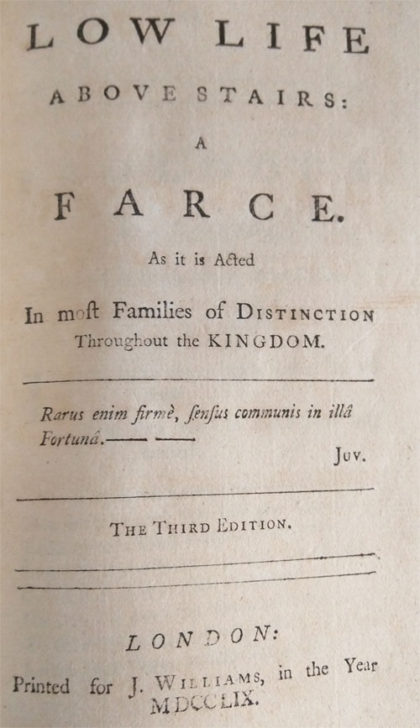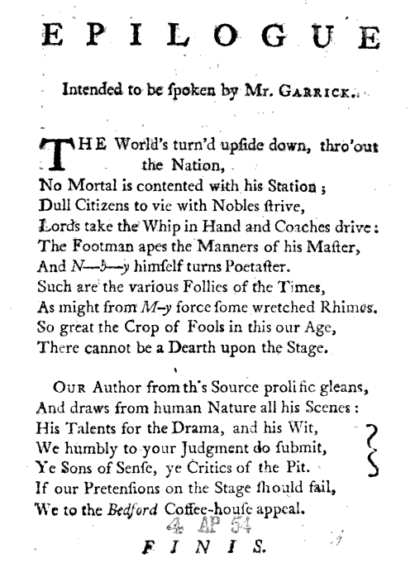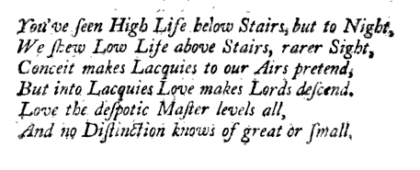Meta; More Farces
Read the title ovid again if you didn’t get the pun.
We have so far looked at two 18th century farces
High Life Below Stairs (1759) &
High Life Above Stairs (1775). aka Bon Ton.
But our list is incomplete. There is a third title that bears examination.
Low Life Above Stairs (1759)
The pamphlet is presented as a two act farce. There’s no evidence it was staged. The only trace I can find is a 3rd edition printed in 1759, the same year the original play was produced. But it contains a letter within the text dated “Nov 6, 1759, which is the day after the date in High Life’s frontispiece. High Life premiered on stage on October 31, 1759. Who knows when Low Life was actually printed. It’s a scandal sheet, bawdy and gossipy. It also spells out what happened. Low Life is on Google Books here.
Over the years Rambler has speculated about the survivability of authorship allusions through time. We have together wondered about how this would survive, and when and where traces would show up. This tour de farce series initial investigation concerned traces of the authorship question in the early 19th century where Sir Walter Scott’s allusions to Vere combine with the reprinting of Robert Armin’s authorship allegory, The Italian Taylor and the Boy. This tour de farce series is about the discovery of a set of allusions including, but not confined to, Rev. Townley’s High Life Below Stairs. The existence of a continuation of authorship questioning across time is important, as it completely debunks a primary argument of tourist-industry aligned scholars, to wit that anti-Stratfordianism sprung randomly from crazed Delia Bacon’s head.
I am not surprised that these threads of authorship questioning and allusions exist and survive into the 18th century. But what is surprising is that, while the threads are few, they are quite transparent. The question “Who wrote Shikspur” is transparent. It’s not hidden under many veils as we’ve learned in the Tudor and Jacobean period. Similarly, in this Low Life farce, much is spelled out for us. For example, the name of Shaxper character who sucks up to the noblemen (and takes their money. Sir William Sycophant. Yes, they aren’t even trying to hide Mr. W. S. from us.
In Bon Ton, Lord Minikin is sanctioned for his foreign vices and he considers in an abomination that he must “submit to the laws of his country.” Low Life contains two lords, Lord Libertine and Lord Lawless representing these facets of Vere. The Duke of Lovesport stands in part for Vere as well. Elizabeth, the Dutchess of Lovesport stands both for the Queen, and in allegory, for the works that are cuckolded from Vere.
I’m not going to guess how much of the sex depicted here occurred, and how much is allegory for other transgressions of possession. But as you read the farce, the principal plot is that the Dutchess has devised a plan for the nobleman to disguise himself as a footman to gain entry to her chamber. The noble aping the lackey is the central theme of this farce. That theme was central in Daniel’s Remarks on Townley’s farce, even though it was not as apparent in the plot. Here it is at the center.
We do learn a key piece of information, which confirms allusions we’ve noted previously. Here’s the Dutchess discussing the disguise.
SCENE V.
Enter the Dutchess of Lovesport and Lord Lawless disguised as а Footman.Lord Lawless. This Disguise removes’ all Obstacles to the Completion of our Desires. We may thus defy the Vigilance ot jealousy, and the Censoriousness of а malicious World. – But why do you fiill defer my Happiness by -these unkind Delays?
Dutchess of Lovesport. You are а strange Man, my Lord, how can you put such a Construction upon an innocent Frolic. When I desired you to take this Disguise, I never once dreamt you would have Carried Things so far; if I had, I should never have proposed it to you.
It was the Queen’s idea for Vere to use Shakespeare’s name. But he took it too far, beyond the point of no return apparently. This is consistent with how the story is portrayed in Jonson’s The Devil is an Ass. There, it is Lady Tayl-bush who changed Devil’s name to De-vile.
One thing we’ve learned from Chapman’s The Gentleman Usher through to these 18th century farces and in so many works we’ve examined in between, is that the crucial nuggets of info we seek are placed at the very beginning and/or at the every end of the work. In Armin’s The Italian Taylor, the authorship saga is neatly condensed in the first 16 lines of the ballad. The end is devoted to Armin telling Will Shaksper what he really thinks of him (not much.) So, let’s cut to the chase here where the anonymous author of Low Life Below Stairs drops a few bombshells about the Shakespeare authorship topic.
Here’s The Epilogue.
The Footman apes the Manners of his Master,
And Nobody himself turns Poetaster.
Can you smell the smoking gun?
Rambler’s “Vere as No-Body” post is here if you need a refresher.
Now if that isn’t satisfying enough. We still have the open question as to Vere’s disgrace. Here are the final stanzas of the farce just prior to the epilogue.
Conceit makes Lacquies to our Airs pretend,
But into Lacquies Love makes Lords descend.
Love the despotic Master levels all,
And no Distinction knows of great or small.
Congratulations to the late Joe Sobran. You had it right all along.
We’ve seen hints before of a homosexual relationship between Vere and Shaksper. Chapman tells us Mendice had “the love of a great Prince.” Jonson in Epicene tells us Sir Amorous La Foole and Sir John Daw are “bedfellows” and he literally places them together in the great “Bed of Ware.” Yet, there was always room for interpretation. But in the 18th century, in the equivalent of a grocery checkout aisle tabloid, the whispers are more clear. The Lord descended into his Lacquies Love. And it leveled him.
My work is done. It is St. George’s Day, 2016, and today I killed a dragon.
April 24, 2016 2 Comments




